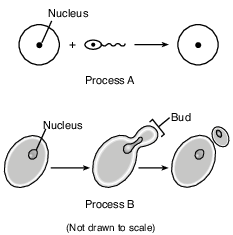Topic: Ansexual Reproduction
Ansexual Reproduction
A significant difference between the effects of the genetic information passed on from asexually reproducing parents to their offspring and sexually reproducing parents to their offspring is the
(1) degree of modification of the size of chromosomes
(2) types of DNA subunits
(3) number of chromosomes in the body cells of the offspring
(4) amount of variation between the parents and the offspring
Aphids, small insects that feed on the sap of plants, undergo asexual reproduction during the summer months. They produce eggs that are formed without the separation of chromosomes. These eggs do not need to be fertilized, and all of the resulting offspring are female.

The best explanation for all of these offspring being female is that
(1) there is not enough food to support male aphids
(2) asexual reproduction produces offspring with many mutations
(3) only the females are able to feed on the sap of the plants
(4) asexual reproduction produces offspring that are genetically identical to the parent
The diagram below represents a form of cellular reproduction.

As a result of this process, offspring 1 and offspring 2 will have
(1) the same number of genes but different traits
(2) a different number of genes but the same traits
(3) the same number of genes and the same traits
(4) a different number of genes and different traits
Female hammerhead sharks sometimes produce offspring by a type of asexual reproduction. These offspring
(1) are a result of the uniting of a male and a fe- male gamete
(2) have cells that contain DNA found only in the female shark
(3) are considered to be a different species from the male parent
(4) have cells that contain genetic information from both parents
The diagram below represents a technique used to produce carrots.

Which reproductive process determines the traits present in the cluster of cells?
(1) meiosis
(2) mitosis
(3) fertilization
(4) differentiation
A student used a microscope to observe a single-celled organism. As he watched, it looked as if the organism split into two cells. He made drawings, shown below, of the organism over a short period of time.

Which process did the student record in his drawings?
(1) genetic engineering
(2) asexual reproduction
(3) selective breeding
(4) gamete formation
The paramecium is a single-celled organism that reproduces asexually. The offspring of a paramecium usually contain
(1) only half of the genes of the parent cells
(2) more DNA than the parent cell
(3) genetic material identical to that of the parent cell
(4) fewer mutations than the parent cell
The ameba, a single-celled organism, reproduces asexually. Variations in an ameba would most commonly occur through
(1) differentiation during development
(2) the fusion of gametes
(3) random mutations
(4) recombination during fertilization
When an organism reproduces asexually, it usually has
(1) only one parent, and half as much DNA as the parent
(2) only one parent, and the same chromosome number as the parent
(3) two parents, and twice as much DNA as either parent
(4) two parents, and the same chromosome number as each parent

Which graph below best represents the DNA content found in each cell in each of the stages in the diagram above?

(1) 1
(2) 2
(3) 3
(4) 4
The diagrams below represent two reproductive processes used by different organisms.

When compared to organisms that utilize process A, organisms that utilize process B would most likely produce offspring with
(1) a greater variety of genetic combinations
(2) fewer genetic differences
(3) more genetic combinations
(4) more DNA within each nucleus
An organism that reproduces asexually will have offspring that have
(1) the same genetic information as both of its parents
(2) different genetic information from either of its parents
(3) the same genes as its parent
(4) different genes from its parent
Identify one way in which the process of growth of a human embryo is similar to the process of reproduction in a single-celled organism. [1]
Allow 1 credit. Acceptable responses include, but are not limited to:
• — They both involve mitosis.
• — Both processes produce cells containing identical genetic information.
• — The cells are produced asexually.
Transgenic (GMO) Tomatoes
The use of pesticides to control insects costs billions of dollars every year. Genetically modified organisms (GMOs) are an attempt to reduce this cost. Tomato plants that are genetically modified can make proteins that are poisonous to the insects that feed on them. Using these GMO tomatoes would reduce the need for the chemical control of insects.

Identify the process responsible for passing the gene for insect resistance in a leaf cell of a genetically modified tomato plant on to the cells that develop from it. [1]
Allow 1 credit. Acceptable responses include, but are not limited to:
• — mitotic cell division/mitosis
• — asexual reproduction
• — cloning
A farmer planted two corn varieties, one of which was very tasty but had small ears, and the other one had large ears but did not taste nearly as good. The pollen from one variety was used to fertilize the other variety of corn. State one biological advantage this method of reproduction has over cloning. [1]
Allow 1 credit. Acceptable responses include, but are not limited to:
• — This method gives the offspring characteristics of each variety, and does not make a copy of
• just one.
• — This method can create new varieties.
• — increases biodiversity
